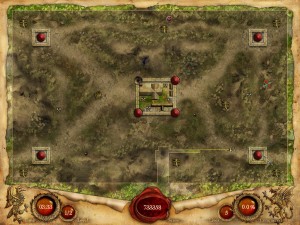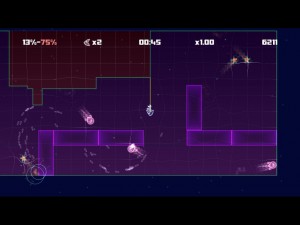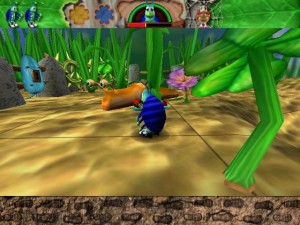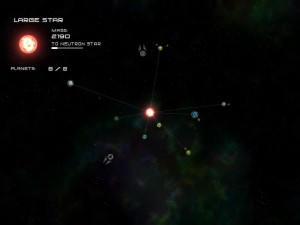The history of Qix is peculiar. It’s one of the foundational titles from the early days of the arcade, one of the ones that blazed its own trail. It’s elegant in its simplicity, highly recognizable, and has been ported to a variety of systems, as well as included in general classic-arcade-game collections. But it never inspired much imitation — it didn’t even get an official update/remake around the year 2000, like Frogger and Qbert did.
Perhaps it’s because it was too simple, too difficult to see how to extend its basic rules (surround territory by drawing a line, enemies that touch either you or the line you’re currently drawing will kill you). The only significant extension of that I saw back in the day was in Gals Panic, which, instead of asking the player to capture a certain percentage of the screen, put a silhouette of a shape on the screen and specifically asked you to capture that. This didn’t make a very great difference to how the game was played — the varying enemy behavior was more significant — but it did introduce one important concept: varying terrain. One of the problems with Qix from a game-designer’s stand point is that, like most games before Donkey Kong, it didn’t have anything distinguishing one level from the next.
Fast-forward to today. I somehow managed to obtain, though bundles or package deals, not one but two distinct recent Qix-based games, without realizing what they were until I tried them. (Furthermore, I coincidentally tried them both within a span of two days.) There’s one thing that both of these games add to the formula: walls. That is, obstacles that block your passage, but which can’t be used to terminate a line the way that the edge of the uncaptured area can. The best thing to do with a wall is to capture it so it doesn’t present an obstacle any more. They also both add randomly-appearing powerups, and eliminate Qix‘s notion of the “spiral death trap” by allowing the player to retract a line in progress. But other than those commonalities, they take the format in very different directions — more different than I’d have thought it afforded.
Lightfish, themed around glowing outline-drawings of sea life, keeps it all pretty abstract and simple, and makes everything very light and fast-moving: on some levels, bisecting the board within the first fifteen seconds is a reasonable goal. The challenge comes mainly from the multitude of fast-moving enemies. It’s Qix as Robotron, essentially. You can kill enemies by capturing the territory enclosing them, but they respawn after a time, so finishing a level quickly is important.
Fortix, themed around capturing forts in a fantasy kingdom, is slower-paced and more tactical. While there are free-roaming dragons on most levels, the chief enemy is stationary towers that lob cannonballs or other projectiles at you. These can be destroyed by capturing a trigger point for one of the level’s single-use catapults, or, if you think you can risk it, by capturing the tower itself — something most easily done by feinting to make them waste a shot and then making a tight loop around them while they reload. Anything, be it tower or dragon, that you catch in a capture is permanently dead, so unless you’re going for a time bonus, there’s no pressure to be reckless — and, in fact, finishing a level without losing a life is rewarded with a shiny crown on the level select screen (presented as a map of the territories you’re conquering).
 Fortix adopts the Gals Panic approach of making only a portion of the screen important for completing the level — specifically, the enemy forts, which are generally where the towers are located. This means that, unlike in Lightfish and the original Qix, it’s possible to capture 100% of the important part, satisfying your perfectionist urges. Not only that, it introduces even greater terrain variation by means of visible features, such as rivers and cliff faces, that slow you down to various degrees, changing the effective routes. In particular, crossing a fort wall is extremely slow, making it virtually necessary to use the catapults before moving in on the tower — except that you can’t control which tower a catapult targets, so perhaps you want to capture an outlying tower or two first so that the easier-to-reach catapults will take out the more difficult inner towers.
Fortix adopts the Gals Panic approach of making only a portion of the screen important for completing the level — specifically, the enemy forts, which are generally where the towers are located. This means that, unlike in Lightfish and the original Qix, it’s possible to capture 100% of the important part, satisfying your perfectionist urges. Not only that, it introduces even greater terrain variation by means of visible features, such as rivers and cliff faces, that slow you down to various degrees, changing the effective routes. In particular, crossing a fort wall is extremely slow, making it virtually necessary to use the catapults before moving in on the tower — except that you can’t control which tower a catapult targets, so perhaps you want to capture an outlying tower or two first so that the easier-to-reach catapults will take out the more difficult inner towers.
 Lightfish, meanwhile, although it does have slow-down terrain in the form of ice blocks, introduces it very late in the game, and mostly treats it as a slightly more forgiving form of wall rather than as a strategic choice: given all the enemies zooming about, unaffected by the ice, you want to avoid it as much as possible. In fact, before it brings out the ice, the one other terrain variation it provides is lava squares, which are identical to walls as far as player choice goes. They’re just walls that give you an opportunity to mess up and die, and that’s not interesting. But it does support the idea that this is more of an action game than Fortix. Where Fortix is more about formulating an effective plan of attack, Lightfish is about not messing up.
Lightfish, meanwhile, although it does have slow-down terrain in the form of ice blocks, introduces it very late in the game, and mostly treats it as a slightly more forgiving form of wall rather than as a strategic choice: given all the enemies zooming about, unaffected by the ice, you want to avoid it as much as possible. In fact, before it brings out the ice, the one other terrain variation it provides is lava squares, which are identical to walls as far as player choice goes. They’re just walls that give you an opportunity to mess up and die, and that’s not interesting. But it does support the idea that this is more of an action game than Fortix. Where Fortix is more about formulating an effective plan of attack, Lightfish is about not messing up.
Lightfish does start becoming more tactical in its later levels, when it starts making walls spiral around in inconvenient ways, but Fortix does a lot more with the concept, including things involving keys that you can capture to open like-colored gates. Between that and the catapults, it has one fundamental concept that Lightfish lacks: that of capturing one point on the map to create effects at a different point. And that seems to be a pretty big deal for creating a satisfying level of depth.
 Bugdom, a 3D save-the-princess piece involving anthropomorphized insects, is a game I associate strongly with computer stores. Apparently it was included with certain models of iMac around the year 2000; as a result, it was frequently what I’d see on those candy-coated monitors in CompUSA as I passed by them on the way to the remaindered PC games. Eventually the game showed up among the remaindered PC games itself, although I don’t remember ever seeing it among the new PC games. Perhaps there was a stigma associated with being initially released on the Mac? Everyone knew that the PC was the computer system for games, after all, and that means that anything originating on a Mac must be, at best, a pseudo-game.
Bugdom, a 3D save-the-princess piece involving anthropomorphized insects, is a game I associate strongly with computer stores. Apparently it was included with certain models of iMac around the year 2000; as a result, it was frequently what I’d see on those candy-coated monitors in CompUSA as I passed by them on the way to the remaindered PC games. Eventually the game showed up among the remaindered PC games itself, although I don’t remember ever seeing it among the new PC games. Perhaps there was a stigma associated with being initially released on the Mac? Everyone knew that the PC was the computer system for games, after all, and that means that anything originating on a Mac must be, at best, a pseudo-game. Comments(3)
Comments(3)

